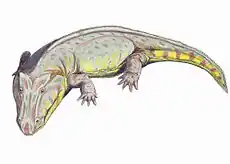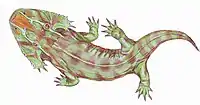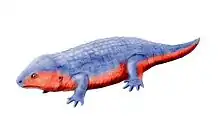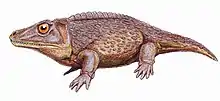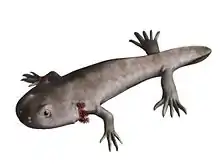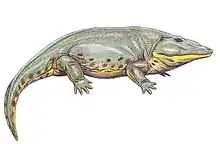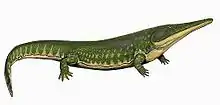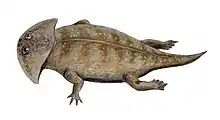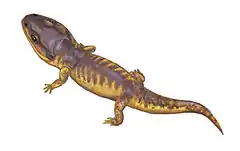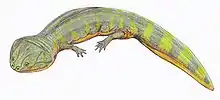Perryella
Perryella is an extinct genus of dvinosaurian temnospondyl. The type and only species, P. olsoni, was named in 1987 from the Wellington Formation of Oklahoma, which is Early Permian in age. It is known from several skulls and partial remains of vertebrae and limbs. It has large orbits, or eye sockets, and large otic notches (rounded indentations at the back of the skull). A bone called the palatine, which is usually found on the underside of the skull, is partially exposed on the top of the skull. Present on the margin of the orbit, the palatine takes the place of the lacrimal bone, which usually touches the orbit in temnospondyls. Another distinguishing feature of Perryella is the presence of two small projections on the quadratojugal bone at the back of the skull. The lowermost projection forms a cup-like shape that attaches to the lower jaw.[1]
| Perryella | |
|---|---|
| Scientific classification | |
| Kingdom: | Animalia |
| Phylum: | Chordata |
| Order: | †Temnospondyli |
| Suborder: | †Dvinosauria |
| Genus: | †Perryella Carlson, 1987 |
| Species | |
| |
The classification of Perryella was at first uncertain because it shared features with two groups, Trimerorhachidae and Dissorophoidea, which were thought to be distantly related.[1] In 2006, a phylogenetic analysis involving Perryella placed it within Dvinosauria as an intermediate form between trimerorhachids and other dvinosaurs.[2]
References
- Carlson, K. J. (1987). "Perryella, a new temnospondylous amphibian from the Lower Permian of Oklahoma". Journal of Paleontology. 61 (1): 135–147.
- Ruta, M.; Bolt, J. R. (2006). "A reassessment of the temnospondyl amphibian Perryella olsoni from the Lower Permian of Oklahoma". Earth and Environmental Science Transactions of the Royal Society of Edinburgh. 97 (2): 113–165. doi:10.1017/S0263593300001437.
